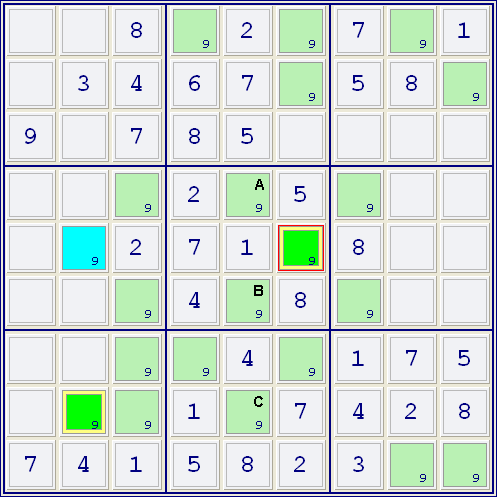| View previous topic :: View next topic |
| Author |
Message |
| AMcK
| | Joined: 07 Apr 2005 | | Posts: 89 | | : | | Location: Cambridge |
Items |
|
 Posted: Fri Sep 16, 2005 11:09 pm Post subject: Posted: Fri Sep 16, 2005 11:09 pm Post subject: |
 |
|
| MadOverlord wrote: | | R3C4 starts out at <168>, and it can't be 8, so that leaves <16>. But other positive statements also exclude values; R6C4=6 knocks out the 6, and R5C4=1 knocks out the 1 |
OK I accept that
r5c4=1 excludes r3c4=1 and
r6c4=6 excludes r3c4=6 and
r1c3=1 excludes r3c4=8
and therefore r5c4=1, r6c4=6 and r1c3=1 can't all be true i.e. at least one of them must be false.
The correct solution is r5c4=9, r6c4=6 and r1c3=5 so in fact two of them are false.
Therefore any implications common to r5c4<>1, r6c4<>6 and r1c3<>1 must also be implications of the at least one true assumption and must therefore be true.
Trouble is my matrices say that there just aren't any common negative implications  |
|
| Back to top |
|
 |
| MadOverlord
| | Joined: 01 Jun 2005 | | Posts: 80 | | : | | Location: Wilmington, NC, USA |
Items |
|
 Posted: Sat Sep 17, 2005 12:06 am Post subject: Posted: Sat Sep 17, 2005 12:06 am Post subject: |
 |
|
| All the information I have about those squares is, IIRC, listed in the postings above. You'll have to look at those to figure out which implications you're missing. |
|
| Back to top |
|
 |
| AMcK
| | Joined: 07 Apr 2005 | | Posts: 89 | | : | | Location: Cambridge |
Items |
|
 Posted: Sat Sep 17, 2005 9:40 am Post subject: Posted: Sat Sep 17, 2005 9:40 am Post subject: |
 |
|
| MadOverlord wrote: | | All the information I have about those squares is, IIRC, listed in the postings above. You'll have to look at those to figure out which implications you're missing. |
Good suggestion - I now have the trebor and ultra r1c3 tables side-by-side in Excel. There's a 90% match but you have implications I don't have - and vice-versa. I'll track them all down and see if this (at last) finds the bug or otherwise solves the paradox. I'll post again when I know the answer - unless Nick70 gets there first again 
Regards
Andrew |
|
| Back to top |
|
 |
| rkral
| | Joined: 21 Oct 2005 | | Posts: 233 | | : | |
Items |
|
 Posted: Sun Jan 01, 2006 12:59 pm Post subject: Posted: Sun Jan 01, 2006 12:59 pm Post subject: |
 |
|
| angusj wrote: |
3. Candidates for an entire group also group with cells of the same conjugate color
 |
Have you implemented this in Simple Sudoku?
If you have any examples handy, would you please post a few of them?
TIA, Ron |
|
| Back to top |
|
 |
| angusj
Site Admin
 | | Joined: 18 Jun 2005 | | Posts: 406 | | : | |
Items |
|
 Posted: Sun Jan 01, 2006 10:29 pm Post subject: Posted: Sun Jan 01, 2006 10:29 pm Post subject: |
 |
|
| rkral wrote: | | Have you implemented this in Simple Sudoku? |
Hi Ron. No I haven't. I think this pattern is both very rare and very hard to spot. I mentioned it more for completeness rather than seeing it as a useful technique to consider (a bit like hidden quads in that respect).
| rkral wrote: | | If you have any examples handy, would you please post a few of them? |
This is the only example I'm aware of. |
|
| Back to top |
|
 |
| rkral
| | Joined: 21 Oct 2005 | | Posts: 233 | | : | |
Items |
|
 Posted: Wed Jan 04, 2006 12:54 pm Post subject: Posted: Wed Jan 04, 2006 12:54 pm Post subject: |
 |
|
| angusj wrote: | | This is the only example I'm aware of. |
Here's two more examples.
In the first, all candidate 6s in row 7 would be eliminated if the color 'blue' represented true.

In the second, all candidate 1s in box 1 would be eliminated if the color 'blue' represented true.

Including the above, I was only able to find 7 sudoku puzzles (one from the top95 and six from the top1465) that exhibited this pattern. They are ... | Code: |
....75....1..2.....4...3...5.....3.2...8...1.......6.....1..48.2........7........
...6.3...74.....1......59.....34...119....7.42...5......1...2...2..6..7....5...6.
1.3.....9..6.......8....54.....49..36......2....1...5...89..2.4..73....1.4.......
6..9.....5..1....71.38....4..6...93.....2.........5.82..1......2.....4138...3....
.6..3....1..2.....2...7..5.9........5..8...41.....29.8.......64.....6.....41.95.2
63......4..5......74..3..6..2.4.5........19......6...7..4.2..9.25.9.8......5..1..
8...7......4..53...7.2...4...9....2..........5.3.8.1...6...4.7.......5.6....67..3 |
Ron
[edits: added links for top95 and top1465]
Last edited by rkral on Wed Jan 04, 2006 1:46 pm; edited 3 times in total |
|
| Back to top |
|
 |
| angusj
Site Admin
 | | Joined: 18 Jun 2005 | | Posts: 406 | | : | |
Items |
|
 Posted: Wed Jan 04, 2006 1:37 pm Post subject: Posted: Wed Jan 04, 2006 1:37 pm Post subject: |
 |
|
| rkral wrote: | | Including the above, I was only able to find 7 sudoku puzzles in the top1465 (actually one might be from the top95) that exhibited this pattern. They are ... |
Hi Ron.
Well done, and many thanks! This pattern is obviously more common than I'd given credit.
However, I'm having trouble with your 5th example. This is as far as I get using "standard" solving techniques (ie excluding forcing chains etc) and I can't see this particular type of colors pattern. Can you enlighten me?
| Code: | *-----------*
|.6.|.3.|2..|
|1..|2..|...|
|2..|.7.|.5.|
|---+---+---|
|9..|...|.25|
|5..|89.|.41|
|...|..2|9.8|
|---+---+---|
|...|...|.64|
|...|..6|...|
|6.4|189|5.2|
*-----------*
*-----------------------------------------------------------------------------*
| 47 6 5789 | 459 3 1458 | 2 189 79 |
| 1 345789 35789 | 2 456 458 | 3478 89 3679 |
| 2 3489 389 | 469 7 148 | 1348 5 369 |
|-------------------------+-------------------------+-------------------------|
| 9 13478 13678 | 3467 146 347 | 367 2 5 |
| 5 237 2367 | 8 9 37 | 367 4 1 |
| 347 1347 1367 | 34567 1456 2 | 9 37 8 |
|-------------------------+-------------------------+-------------------------|
| 378 1259 1259 | 357 25 357 | 1378 6 4 |
| 378 125 125 | 3457 245 6 | 1378 189 379 |
| 6 37 4 | 1 8 9 | 5 37 2 |
*-----------------------------------------------------------------------------* |
|
|
| Back to top |
|
 |
| rkral
| | Joined: 21 Oct 2005 | | Posts: 233 | | : | |
Items |
|
 Posted: Wed Jan 04, 2006 2:01 pm Post subject: Posted: Wed Jan 04, 2006 2:01 pm Post subject: |
 |
|
| angusj wrote: | | I'm having trouble with your 5th example. |
r9c2=3 and r6c8=3 would exclude all candidate 3s from column 1. |
|
| Back to top |
|
 |
| angusj
Site Admin
 | | Joined: 18 Jun 2005 | | Posts: 406 | | : | |
Items |
|
 Posted: Wed Jan 04, 2006 2:12 pm Post subject: Posted: Wed Jan 04, 2006 2:12 pm Post subject: |
 |
|
| rkral wrote: | | r9c2=3 and r6c8=3 would exclude all candidate 3s from column 1. |
Arh, quite so. Thanks! |
|
| Back to top |
|
 |
| rkral
| | Joined: 21 Oct 2005 | | Posts: 233 | | : | |
Items |
|
 Posted: Wed Jan 04, 2006 5:47 pm Post subject: Posted: Wed Jan 04, 2006 5:47 pm Post subject: |
 |
|
| angusj wrote: | | This pattern is obviously more common than I'd given credit. |
My search used only "simple" coloring, i.e., it used one conjugate chain. I expect applying this rule with multi-coloring -- multiple conjugate chains for one digit -- would advance more puzzles than simple coloring did.
For example, consider the following puzzle with two conjugate chains.

If 'blue' represents true, so will 'orange' because 'blue' excludes 'pink' ... and thus if 'blue' were true all 1s in column 2 would be eliminated. Therefore, 'blue' must represent false.
P.S. Hint, hint, I ran out of colors for column 2.  |
|
| Back to top |
|
 |
| angusj
Site Admin
 | | Joined: 18 Jun 2005 | | Posts: 406 | | : | |
Items |
|
 Posted: Wed Jan 04, 2006 10:17 pm Post subject: Posted: Wed Jan 04, 2006 10:17 pm Post subject: |
 |
|
| rkral wrote: | | My search used only "simple" coloring, i.e., it used one conjugate chain. I expect applying this rule with multi-coloring -- multiple conjugate chains for one digit -- would advance more puzzles than simple coloring did. |
Yes, you're absolutely right. Now, I'm left to contemplate whether or not to support this in Simple Sudoku. (Perhaps it's something for the metaphorical rainy day.)
| rkral wrote: | | P.S. Hint, hint, I ran out of colors for column 2. |
 |
|
| Back to top |
|
 |
|






